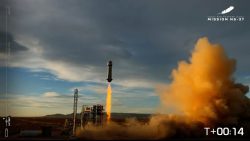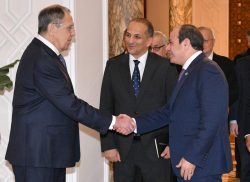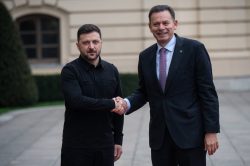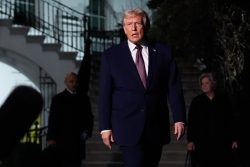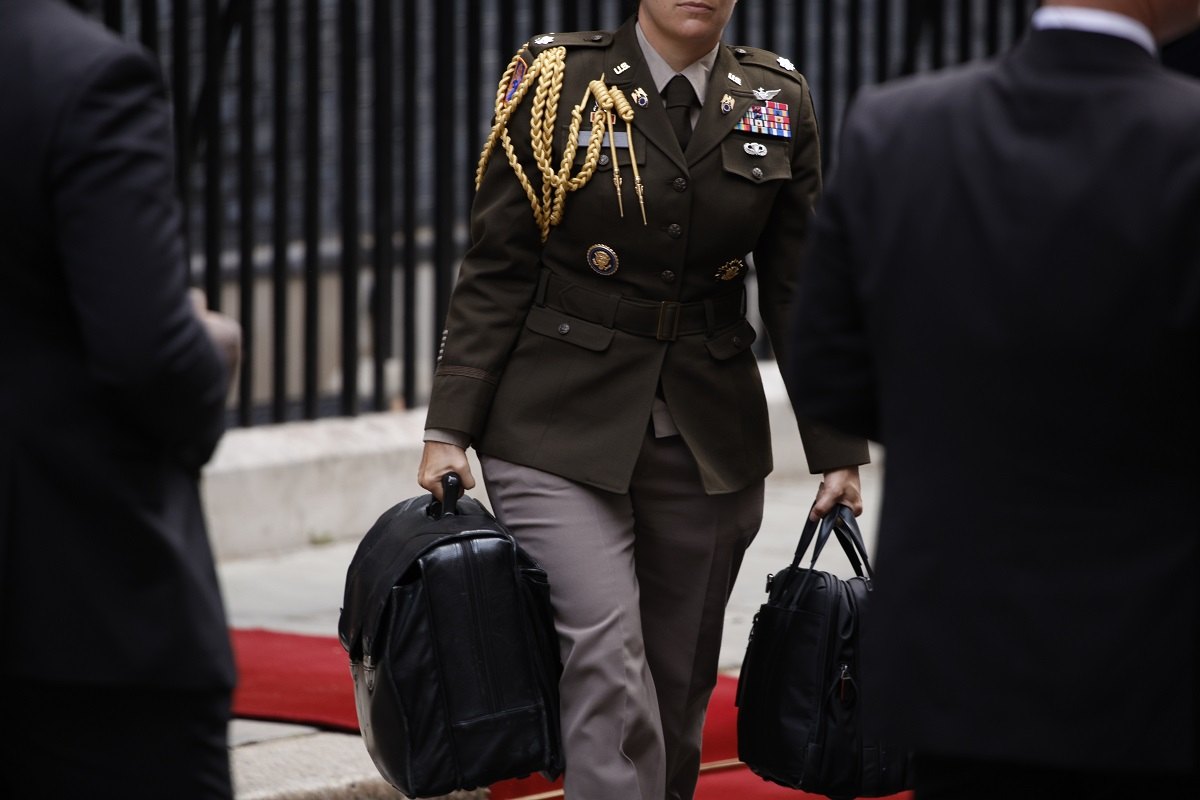
A military aide carries the Presidential Emergency Satchel, also known as the “nuclear football,” out of 10 Downing Street in London on Monday, July 10, 2023, after a meeting between Prime Minister Rishi Sunak and U.S. President Joe Biden.
11:51 JST, July 19, 2023
WASHINGTON (AP) — The most important — and mysterious — “football” in the world isn’t really a football at all.
Officially called the “ Presidential Emergency Satchel, ” the “nuclear football” is a bulky briefcase that contains atomic war plans and enables the president to transmit nuclear orders to the Pentagon. The heavy case is carried by a military officer who is never far behind the president, whether the commander-in-chief is boarding a helicopter or exiting meetings with world leaders.
Beyond those basic facts, however, not much is known about the satchel, which has come to symbolize the massive power of the presidency. Let’s change that.
William Burr, a senior analyst at the nonprofit National Security Archive at George Washington University, published a report Tuesday detailing his recent research into the presidential pigskin. Among the tidbits Burr unearthed: The football once contained presidential decrees that some in the U.S. government came to believe were likely illegal and unnecessary (there would be nobody left alive to implement them in the event of a nuclear holocaust).
Burr, who has spent three decades researching and writing about nuclear war planning and history, sat down with The Associated Press recently to talk about his research and the nuclear football’s history. The interview has been lightly edited and condensed for clarity:
WHAT IS THE ‘FOOTBALL’? WHEN DID IT FIRST GET DESCRIBED THAT WAY?
In the beginning, there was the president’s “emergency satchel” or “the black bag.” During the late 1950s, President Dwight D. Eisenhower and his advisers worried about the United States’ vulnerability to a nuclear surprise attack. So the president could make quick decisions on the spot, a military aide started carrying a satchel of documents that would help the president communicate with the Pentagon or other military headquarters.
The satchel also included presidential proclamations — Presidential Emergency Action Documents, or PEADS — declaring a national emergency and expanding executive power to deal with the crisis. Initially the satchel and military aide followed the President only during travel outside of Washington, D.C. Eisenhower passed the satchel on to his successor, John F. Kennedy, and sometime in the early 1960s it also became known as the football, perhaps because of the Kennedy family’s liking for touch football.
WHY SO MUCH INTEREST IN IT?
The explanation is the secrecy and the problem of nuclear risk and danger. The idea of a military aide following the president, carrying a locked bag with secret nuclear information, is a routine for the modern U.S presidency that has intrigued journalists and historians and the public. The idea that the president needs to be able to make speedy decisions in a perilous moment conveyed the ultimate danger of nuclear weapons. That the football system has lasted since the late 1950s adds to the mystery.
WHAT GOT YOU STARTED?
My research at the National Security Archive has partly focused on command-and-control arrangements for nuclear weapons. On command and control, some good information has been declassified over the years. But there are so many aspects to the nuclear problem that I did not look into the history of the football as early as I should have. Unfortunately, but not too surprising, only a smattering of information has been declassified. Even the few relevant documents from the 1960s are heavily excised.
THE FOOTBALL CHANGED DURING THE CARTER ADMINISTRATION. TELL US MORE.
The football included emergency proclamations that, as the Carter administration found out, had not been updated for years. And there was concern about the legality of some of them. Also, White House officials recognized that the comprehensive devastation of nuclear war could make the proclamations irrelevant. By the early 1980s, the presidential directives had been revised, but how they were changed has not been disclosed. Whether there were still worries about their legality is also an open question.
AND THE VICE PRESIDENT SOMETIMES HAS ONE, TOO?
Apparently when Richard Nixon was vice president he was assigned a black bag. The next vice president, Lyndon Johnson, declined a black bag. When Kennedy was assassinated in Dallas, top military commanders worried that the new president did not know what was in the football so they made sure that a White House military aide gave him a briefing after he arrived in Washington.
If any of the vice presidents from Hubert Humphrey to Nelson Rockefeller had a military aide carrying a football it has not been disclosed, so far as I know. But President Jimmy Carter was aware of the vulnerability problem and made sure that his vice president, Walter Mondale, had a military aide carrying the football.
SEEMS LIKE THE FOOTBALL IS EVERYWHERE AND NOWHERE. HOW DID YOU APPROACH UNEARTHING A SECRET THAT HIDES IN PLAIN SIGHT?
You’ve put your finger right on the problem — everywhere and nowhere. For example, we can see the military aide carrying the bag behind Vice President Mike Pence during the Jan. 6, 2021, riots at the U.S. Capitol. But its contents remain as inscrutable as they were 50 years ago. The Archives’ new posting includes photos of the military aide carrying the football, sometimes with the president in different situations. From some of the photos, you can see what looks like a little antenna projecting from the bag, suggesting that it includes communication devices. As far as the contents go, some details have been leaked and some general information has been declassified — but very little in the way of specifics.
"News Services" POPULAR ARTICLE
-

American Playwright Jeremy O. Harris Arrested in Japan on Alleged Drug Smuggling
-

Japan’s Nikkei Stock Average as JGB Yields, Yen Rise on Rate-Hike Bets
-

Japan’s Nikkei Stock Average Licks Wounds after Selloff Sparked by BOJ Hike Bets (UPDATE 1)
-

Japanese Bond Yields Zoom, Stocks Slide as Rate Hike Looms
-

Japan’s Nikkei Stock Average Buoyed by Stable Yen; SoftBank’s Slide Caps Gains (UPDATE 1)
JN ACCESS RANKING
-

Keidanren Chairman Yoshinobu Tsutsui Visits Kashiwazaki-Kariwa Nuclear Power Plant; Inspects New Emergency Safety System
-

Imports of Rare Earths from China Facing Delays, May Be Caused by Deterioration of Japan-China Relations
-

University of Tokyo Professor Discusses Japanese Economic Security in Interview Ahead of Forum
-

Japan Pulls out of Vietnam Nuclear Project, Complicating Hanoi’s Power Plans
-

Govt Aims to Expand NISA Program Lineup, Abolish Age Restriction


